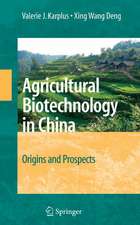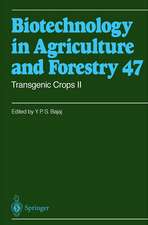Genetic Improvement of Bioenergy Crops
Editat de Wilfred Vermerrisen Limba Engleză Hardback – 24 aug 2008
Genetic Improvement of Bio-Energy Crops focuses on the production of ethanol from lignocellulosic biomass, which includes corn stover, biomass from dedicated annual and perennial energy crops, and trees as well as a number of important biomass crops. The biomass is typically pretreated through thermochemical processing to make it more amenable to hydrolysis with cellulolytic enzymes. The enzymatic hydrolysis yields monomeric sugars that can be fermented to ethanol by micro-organisms. While much emphasis has been placed on the optimization of thermo-chemical pretreatment processes, production of more efficient hydrolytic enzymes, and the development of robust microbial strains, relatively little effort has been dedicated to the improvement of the biomass itself.
| Toate formatele și edițiile | Preț | Express |
|---|---|---|
| Paperback (1) | 933.40 lei 43-57 zile | |
| Springer – 28 oct 2010 | 933.40 lei 43-57 zile | |
| Hardback (1) | 937.43 lei 43-57 zile | |
| Springer – 24 aug 2008 | 937.43 lei 43-57 zile |
Preț: 937.43 lei
Preț vechi: 1143.21 lei
-18% Nou
Puncte Express: 1406
Preț estimativ în valută:
179.40€ • 186.36$ • 149.02£
179.40€ • 186.36$ • 149.02£
Carte tipărită la comandă
Livrare economică 03-17 februarie 25
Preluare comenzi: 021 569.72.76
Specificații
ISBN-13: 9780387708041
ISBN-10: 0387708049
Pagini: 449
Ilustrații: XXII, 450 p. 35 illus., 7 illus. in color.
Dimensiuni: 155 x 235 x 25 mm
Greutate: 0.77 kg
Ediția:2008
Editura: Springer
Colecția Springer
Locul publicării:New York, NY, United States
ISBN-10: 0387708049
Pagini: 449
Ilustrații: XXII, 450 p. 35 illus., 7 illus. in color.
Dimensiuni: 155 x 235 x 25 mm
Greutate: 0.77 kg
Ediția:2008
Editura: Springer
Colecția Springer
Locul publicării:New York, NY, United States
Public țintă
ResearchCuprins
I.- Why Bioenergy Makes Sense.- A Primer on Genetics, Genomics and Plant Breeding.- Production of Ethanol from Grain.- Composition and Biosynthesis of Lignocellulosic Biomass.- Selection of Promising Biomass Feedstock Lines Using High-Throughput Spectrometric and Enzymatic Assays.- Current Technologies for Fuel Ethanol Production from Lignocellulosic Plant Biomass.- II.- Genetic Improvement of Corn for Lignocellulosic.- Development and Utilization of Sorghum as a Bioenergy Crop.- Genetic Improvement of Sugarcane (Saccharum spp.) as an Energy Crop.- Miscanthus: Genetic Resources and Breeding Potential to Enhance Bioenergy Production.- Improvement of Switchgrass as a Bioenergy Crop.- Improvement of Perennial Forage Species as Feedstock for Bioenergy.- Genetic Improvement of Willow (Salix spp.) as a Dedicated Bioenergy Crop.- Genetic Improvement of Poplar (Populus spp.) as a Bioenergy Crop.- Southern Pines: A Resource for Bioenergy.
Textul de pe ultima copertă
Genetic Improvement of Bioenergy Crops
Wilfred Vermerris, Editor
Bioenergy is attracting increasing attention in science, industry, politics and the media as a means to address energy security, global climate change and economic sustainability. Biofuels – ethanol and biodiesel – currently represent the only alternative and renewable energy source available as liquid transportation fuel. The current production of biofuels relies heavily on food crops: grain and sugar for ethanol, and plant oils for biodiesel. This has raised serious concerns about food supplies, food prices, and long-term sustainability. Second-generation biofuels are derived from dedicated bioenergy crops that produce plant cell wall polysaccharides as the main source of fermentable sugars, as well as algae and non-edible oil crops as a source of oils and lipids for biodiesel.
The development of dedicated bioenergy crops requires an entirely different approach to plant improvement than what has been traditional for food, feed and fiber crops. This book presents an overview of the major bioenergy crops that can be used for the production of biomass and ethanol, with a focus on their genetic improvement. In order to maintain focus, biodiesel and the genetic improvement of oil crops are not covered. The available genetic resources are largely untapped and offer major opportunities to significantly enhance the contribution of bioenergy, while addressing many of the economic and ecological concerns.
The chapters have been written by experts in their field and target university students in plant sciences, biological engineering, or related disciplines, enrolled in a course on bioenergy crops. Researchers in academia and industry will find this book useful as well. The first part of the book provides background on the politics of bioenergy, the current ethanol production process, the biosynthesis and analysis of plant cell walls, andprocessing of biomass, and includes a primer on genetics and plant breeding. The second part of the book focuses on the genetic resources available to enhance individual herbaceous and woody species for use as bioenergy feedstocks. As a whole, Genetic Improvement of Bioenergy Crops provides the first comprehensive overview of the tremendous potential of dedicated bioenergy crops.
Wilfred Vermerris is Associate Professor at the Genetics Institute and Agronomy department at the University of Florida in Gainesville, where he manages an active research program on plant cell walls and their use in bioenergy applications. He is also faculty associate with the University of Florida’s Plant Molecular and Cellular Biology graduate program, Adjunct Associate Professor in Agricultural & Biological Engineering at Purdue University and adjunct faculty member of Purdue University’s Laboratory of Renewable Resources Engineering. He is co-author of the book Phenolic Compound Biochemistry (Springer 2006) and one of the three Co-Editors-in-Chief of the journal BioEnergy Research.
Wilfred Vermerris, Editor
Bioenergy is attracting increasing attention in science, industry, politics and the media as a means to address energy security, global climate change and economic sustainability. Biofuels – ethanol and biodiesel – currently represent the only alternative and renewable energy source available as liquid transportation fuel. The current production of biofuels relies heavily on food crops: grain and sugar for ethanol, and plant oils for biodiesel. This has raised serious concerns about food supplies, food prices, and long-term sustainability. Second-generation biofuels are derived from dedicated bioenergy crops that produce plant cell wall polysaccharides as the main source of fermentable sugars, as well as algae and non-edible oil crops as a source of oils and lipids for biodiesel.
The development of dedicated bioenergy crops requires an entirely different approach to plant improvement than what has been traditional for food, feed and fiber crops. This book presents an overview of the major bioenergy crops that can be used for the production of biomass and ethanol, with a focus on their genetic improvement. In order to maintain focus, biodiesel and the genetic improvement of oil crops are not covered. The available genetic resources are largely untapped and offer major opportunities to significantly enhance the contribution of bioenergy, while addressing many of the economic and ecological concerns.
The chapters have been written by experts in their field and target university students in plant sciences, biological engineering, or related disciplines, enrolled in a course on bioenergy crops. Researchers in academia and industry will find this book useful as well. The first part of the book provides background on the politics of bioenergy, the current ethanol production process, the biosynthesis and analysis of plant cell walls, andprocessing of biomass, and includes a primer on genetics and plant breeding. The second part of the book focuses on the genetic resources available to enhance individual herbaceous and woody species for use as bioenergy feedstocks. As a whole, Genetic Improvement of Bioenergy Crops provides the first comprehensive overview of the tremendous potential of dedicated bioenergy crops.
Wilfred Vermerris is Associate Professor at the Genetics Institute and Agronomy department at the University of Florida in Gainesville, where he manages an active research program on plant cell walls and their use in bioenergy applications. He is also faculty associate with the University of Florida’s Plant Molecular and Cellular Biology graduate program, Adjunct Associate Professor in Agricultural & Biological Engineering at Purdue University and adjunct faculty member of Purdue University’s Laboratory of Renewable Resources Engineering. He is co-author of the book Phenolic Compound Biochemistry (Springer 2006) and one of the three Co-Editors-in-Chief of the journal BioEnergy Research.
Caracteristici
Provides an overview of the many exciting advances that have been made in utilizing the wonderful resources in the plant world Discusses the technology needed to produce ethanol from lignocellulosic biomass Presents the use of mutagenesis, breeding and selection, and transgenic strategies Discusses genetic and biotechnological approaches that can be implemented to improve biomass conversion efficiency for a number of relevant agronomic crops and tree species



























